Inglewood Farm through Art and Reflection
Inglewood Farm, located in Alexandria, Louisiana, is widely featured in the personal stories and artwork of Kathryn Keller and her daughter Hannah Timmons. When Keller’s grandfather purchased Inglewood in 1926, it came with a colorful history, having survived the Civil War while surrounding plantations were destroyed by Union soldiers. Keller’s father and mother operated Inglewood as a commercial farm with tenant farmers. Kathryn and her siblings, their spouses, and children have since converted the farm into an organic farm that is now known for its pecans groves, organic fruits and vegetables, and eggs.
Kathryn and Hannah are among a number of family members who reside at Inglewood on a full- or part-time basis. Kathryn has spent years painting the landscape and the houses that occupy the land that she has known her whole life. Hannah, curious about the story of the farm after completing acting school in New York City, moved back down to Inglewood alongside her wife, Paige Harris, to make a film about its history. They stayed for one year before moving to Virginia, where Hannah is at work editing and illustrating the film with plans to move back part-time. When Hannah set out to document the history of Inglewood and its transition from a plantation to an organic farm, she didn’t anticipate how the story would unfold through the close-knit relationships she formed with those who had worked the land. It has informed the direction of the film as well as conversations that the larger family is having about coming to terms with the inequalities of those who worked the land and those who profited from that labor.
South Writ Large asked Kathryn and Hannah to share their reflections on their art and this particular land that continues to occupy their imaginations. The resulting phone conversation between the two of them was edited and redacted. The mother and daughter exchanged thoughts on the process and discipline of making art in their individual mediums, the importance of Inglewood Farm, which features prominently in their work, the African American families who lived there, and the important role they played in the land’s history as well as in their personal lives. The reader must know that the text cannot begin to capture the laughter, warmth, and genuine affection of the conversation.
***
Hannah: Mom, how do you feel when someone asks you to talk about your work?
Kathryn: I feel silent, stopped up. It’s very hard for me to talk about my work. I think sometimes if somebody asks the right question, then it gets easy. Or if the person makes me feel comfortable, then I feel like I am able to be completely honest.
Hannah: Paige was asking me some questions when we were in the car today, and that is a pretty accurate description of how I felt—silent. Then I felt mad at myself for not being able to answer questions. I should be able to be articulate my artistic process.
Kathryn: I suppose so, except supposedly if we were articulate and good with words we would be writers and not filmmakers. We wouldn’t be visual artists.
Hannah: True.
Kathryn: I was just on the way home, listening to the radio and [I] heard a poem by a man who died recently, W. S. Merwin, and he read this poem he wrote. It was a very short poem but it made me weep. And I thought, “Oh, man, if I could, I would love to be able to be a poet.” What he captured felt so familiar. I would love to be able to use words and make somebody cry. But, I guess we have to do what we can do.
Hannah: Indeed. You used to write?
Kathryn: Well, I did try for a while. When I wasn’t liking my work. So I said I’m quitting.
Hannah: Wait, when was that?
Kathryn: That was when we lived on St. Charles Avenue [in New Orleans] and you were probably about eight. It lasted maybe a few months then I decided to paint the wall downstairs and that got me back into painting.
Hannah: Not a painting of the wall, but to actually paint the wall? I don’t remember you doing that.
Kathryn: I painted hand-painted wallpaper, wallpaper flowers on the wall. It took about a year. I had to get a tall ladder.
Hannah: And after you finished that you started painting again? What caused you to stop?
Kathryn: I got frustrated. I was doing those figurative expressionist works. I was drawing it out of my head, making paintings of the figure and I didn’t like the way they looked. I wanted them to look more realistic, more correct. I started wondering if I knew how to draw and I felt like a fraud. I wanted to make sure I knew how to draw. So I went back to school and began taking classes again at the [New Orleans] Academy [of Fine Arts]. I’d taken Academy classes all my life, and I’d worked from the figure before, but I couldn’t get the figure and, to this day, I just can’t draw the figure unless I’m looking at it live. That is what made me decide I only wanted to work from life.
Hannah: You haven’t broken from life ever since?
Kathryn: No.
Hannah: I sometimes feel like a fraud with the film’s animation because of the technique I’m using for animating stories in my film. I’m using footage that I’ve filmed and then I’m drawing over top of the footage. It’s not coming from my head. I don’t think it’s an uncommon animation tool.
Kathryn: It’s also not uncommon for artists to feel like a fraud.
Hannah: (Laughter) There’s probably something every day that makes me feel like a fraud. Not necessarily the tools I’m using but this sense of, “I’m not an artist. What right do I have to be an artist?”
Kathryn: You are so obviously an artist. When I look at this oil painting you did, the first back in January—I’m looking at it right now—it is just amazing. You have such a gift.
Hannah: Thank you for saying that.
Kathryn: It’s got such presence. All of your work has always had a lot of presence.
Hannah: I hope that will come through in my film.
Kathryn: I think in your film, your presence is very felt.
***
Hannah: I went through some of the footage I took of you painting [longtime Inglewood Farm resident] John Ashley’s portrait. It was hard to watch it because he’s not with us anymore. . . . And I struggled to find the footage I was looking for. But I did find the part where you said you saw your father in the portrait of John.
Kathryn: I saw my father in his face? I said he looked like my father?
Hannah: Yes, you said “I see my dad in this.”
Kathryn: Oh, really? That’s interesting. I don’t remember. You mean, I was looking at my painting and I said that?
Hannah: You also said that you had heard “when you paint a portrait, you are always also painting your own portrait.” It made me wonder if Inglewood, where you live and paint, is more of a person to you than a place, and that you are always painting its portrait.
Kathryn: Probably. I’m also probably painting a portrait of myself in every painting. I’m certainly painting my emotions without thinking about it. You probably do the same thing. You’re not aware when you’re drawing frames of how you feel and you’re certainly not trying to impart a certain emotion into the work, but it comes through your subconscious. It would be really awful if you tried to stick emotion on it. It wouldn’t work. That would be fraudulent.
Hannah: That’s right.
***
Hannah: Do you feel any responsibility to how you represent Inglewood in your work? Do you think about that when you are painting?
Kathryn: If I felt a responsibility that would cripple me. I couldn’t work if I felt a responsibility. So that’s definitely not what motivates me. I just paint where I am. You know I haven’t done portraits in a long time, but I was painting the people that I love and that was an honor to do—an honor that Nancy sat for me, John sat for me, you sat for me, and Rachel and Jesse—it’s such an honor. And when I’m painting the landscape or interiors, it’s because I’m painting where I am. It’s as simple as that for me. Hopefully by capturing the uniqueness of the place, by describing a specific place well, it will begin to resonant and feels universal. It’s a paradox: the better you can describe the uniqueness of a place, the more universal it seems.
Hannah: That all makes sense. When we lived on Inglewood and I was embarking on my project, at first I thought I was making a film about my family’s organic farm and its journey: a commercially farmed operation that was previously something between commercially farmed and a plantation, and even further back was simply no holds barred a plantation. I was going to tell that whole story. But something shifted. I don’t know what, but when we lived on Inglewood, it just changed. We became friends with John and Georgia. I had to tell the story that was unfolding before my eyes, which is what John was sharing with us, his life, his experience of Inglewood. That’s all I know how to do.
Kathryn: You followed your heart.
Hannah: I couldn’t . . . I couldn’t do anything else.
Kathryn: You worked with what was right in front of you.
Hannah: We literally ran into him every few days while we were living there and we just became partners in crime, running around Inglewood.
Kathryn: Yes and especially for your film, it is so much richer because you focused on a person and that person’s outlook on life and that person’s story. I guess in the end, it’s people that make life interesting. Right? Hearing people’s stories? That’s what gives us a feeling of, “We’re not alone in this world.”
Hannah: Right. John and the other people that are in my film who shared stories with me—they made Inglewood possible. A long line of people made Inglewood possible. And we both now benefit from their labor and now Inglewood supports our work in so many ways.
***
Kathryn: It’s so pretty here right now. It’s in the 40s when you wake up, so you think. “Oh, yes it’s still spring.” But it did get rather warm this afternoon. You think oh, no, it’s too hot for March but it’s just hard to complain because it’s just gorgeous all the trees are leafing out.
Hannah: Does it make you want to go out there and paint?
Kathryn: I haven’t wanted to go outside because I’m having so much fun inside in my studio painting those big huge interiors and listening to classical music. I’m going to have to wean myself from that to go back outside. Because I can’t keep doing the same thing for too long. I start to feel like I need to change.
Hannah: You would hate doing the animation.
Kathryn: Because you’re stuck? Well, no, I’m sure you’re not stuck.
Hannah: It can get monotonous, but I have to find the shift in each frame. And actually it never gets monotonous drawing John over and over and over again. I don’t know what it is that I find about him so . . .
Kathryn: Well, now you just miss him.
Hannah: But even before he died, I don’t know what it is—just something in his face and his spirit shines so bright.
Kathryn: He was a father figure to you?
Hannah: I don’t know if he was a father figure. I think more just an unexpected friend. So, it’s hard. I think it’s hard for me to make friends because I’m very introverted and shy. I think he was too and we related to each other in that way. Paige connected to him in her own way and it was just fun the time we had together.
Kathryn: I feel a similar relationship to Nancy, but it’s gotten so complicated. I just love Nancy and I think she really loves me. She makes me laugh and I want to hear her stories.
Hannah: I mean, all relationships are complicated and this one has the layers of history.
Kathryn: That we can’t get away from. I can’t get away from the fact that she grew up in a tiny tenant house and I grew up . . .
Hannah: In the big house.
Kathryn: In the Inglewood house. And that she wasn’t allowed in the house when we were. It wasn’t that she wasn’t allowed, it just didn’t happen. [Those that worked on the farm] just didn’t come in the house. There was an unspoken rule. And I always felt awful. It felt really weird to me. I don’t remember playing with Nancy. I didn’t know Nancy then. I’m talking about other people, B-Boy’s children.
Hannah: I wonder, I was telling Paige today that I just have so much doubt about whether or not I can do justice to the people and to the stories that were shared with me because of who I am and where I come from.
Kathryn: But you have to, it’s your story. It’s the story told through you. So that’s just the way it is. You can’t avoid that. You’re telling a story. You are the storyteller. So, it has your outlook in it. You saw the value in their stories, the importance of them—the saving, recording, and telling of those stories. That’s so amazing that you’ve done that. You’ve gotten their voices in there. You’ve gotten them telling their own story and in their own words, and you’ve captured it on film.
***
Hannah: Do you have a favorite place on Inglewood?
Kathryn: Oh gosh—they just made a path, all the way along the bayou. You know the path that Steve started? Antonio mowed a path all the way down the fence line of the cow pasture to the other end of the road and it is like seeing part of Inglewood for the first time. Now you can walk by those gigantic live oaks. It’s such a beautiful walk. It’s amazing. When you see those live oaks from across the road, they look wonderful and beautiful. But when you walk underneath them, they look even more powerful and gorgeous. You’re going to love it, your dogs are going to love it.
Hannah: Our dogs will love it no matter what. That’s their favorite place.
Kathryn: There’s no doubt that when you sit down to paint a place, you don’t necessarily see it for the first time, but you record it for the first time and it’s a kind of love. You fall in love with it in a new way, I think. Or you hate it, because you’re not able to get it. That happens a lot too, to me, I think, “Oh my god, I used to really love this view and now I hate it because I can’t get it.”
Hannah: Do you ever feel like you will exhaust the views? You say, “I’ve got it, I’ve painted that and there are no other views left?”
Kathryn: “I’ve done it. I’ve done it all. I have to move?”
Hannah: Do you think that’s possible or not?
Kathryn: No, because I guess I’m not going anywhere else (laughter), but I don’t know. I haven’t been outside in the landscape for a while now, but sometimes I feel like I have exhausted my house so I’m working in the studio. Now I’m starting to think maybe I’m exhausting the studio. So I don’t know. In this current series, so far every time I’ve started something, I think “Oh, okay, this is good. This is new. Now I’m really getting it. Now it’s really getting better. Now I’m seeing better.” So sometimes, for me, I just have to start. I certainly can’t wait for inspiration. Sometimes I just have to set it up and start it. Because if I don’t, then I lose my flow, I’ll lose my skill. So you just start by trying something and see where it takes you.
Hannah: That part of me kicks in with the film when I’m trying to figure out how to animate a story. I have to sit there and mull over it and figure it out. Then at some point if I can’t, I just have to start working. And I take a go at animating the person telling the story. I have to work. I have to try. That is the best, or the least I can do. Try—with good intention.
Kathryn: That’s right.
Hannah: And hopefully that will be good. Or reveal something.
***
Portfolio: Kathryn Keller
- Ashore. 2017, Oil on Paper.
- Native Pecans. 2015, Oil on Canvas.
- Sense of Place. 2016, Oil on Paper.
- Betty’s House. 2016, Oil on Paper.
- November. 2016, Oil on Canvas.
- House at Inglewood. 2016, Oil on Paper.
- Bleakhouse Cedars. 2016, Oil on Gessoed Paper.
- Discarded. 2017, Oil on Paper.
- Front Porch. 2016, Oil on Paper.
- Triangle of Light. 2016, Oil on Paper.
When I first painted a pine tree, I first loved a pine tree. Before I painted the tree, I thought “How Inferior to other trees they are!” But in the painting of the pine tree, I learned how it was made. I marveled in the architecture of it.
Painting outside allows for moments of bliss. A flock of migrating waxwings descends to devour the hackberries in the tree under which I am painting. It also has its tribulations, gnats being among the worst.
When I work from the human figure I revel in the physical pleasures of painting. I love the smell of oil paint, the array of thick gobs of color waiting to be plunged into, the visceral application of paint. I scrape, wipe, smear, glaze. Often I have to lose the image in order to find it again. I focus on shape and color relationships. If I manage to capture the poignancy of a gesture or of the expression in the eyes, I am happy.
When I paint interiors I try to capture a particular moment in time: How, for instance, the sunlight streaming in from the window just now makes the silver goblet sparkle.
When I travel, I paint with watercolors. The watercolors are different in tone from the oils. They are less serious. Water, won’t be pushed around. It will have its own way, so the paintings are more spontaneous, immediate and light hearted. I see irony in them. Good things can happen quite by accident, as if by magic.


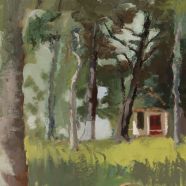





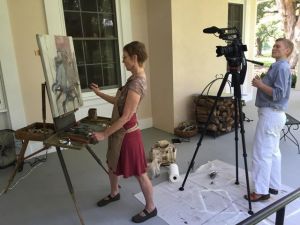
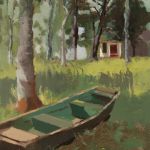
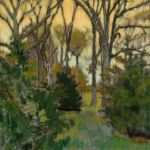
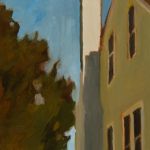
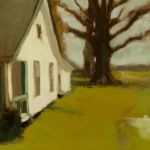
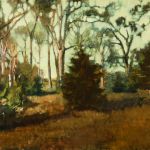
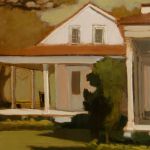
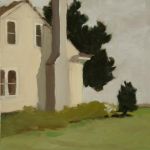
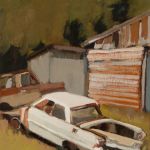
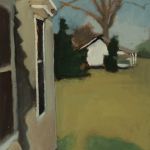
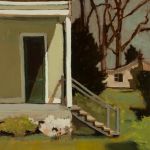
What an amazing conversation between mother & daughter artist.. I love both of these smart, talented, articulate women. I know & admire Kathryns art & look forward to seeing more of Hannah’s documentary.
Kathryn and I are long time friends and that friendship has been and continues to be , a treasure in my life.
One of my pleasures has been to see Kathryn’s talent and strength grow and move her to “speak ” even more clearly through her work. Kathryn knows what she is about and we are the better for it. She is a marvelous artist .
I am a fan of Hannah as a person and I look forward to seeing some of her work.
The exchange between Kathryn and Hannah was a great idea and certainly gave us more insight into the work of each artist.
The dominant thought after enjoying such a delightful conversation and each offering of art is how authentic are the voices of my dear friends. I want to thank them just for being who they are.
I so enjoyed reading this! The heart between you two is really special. Inglewood has such an energy about it, and it is given even more life through Kathryn’s paintings and Hannah’s film. I am really excited for this film. It is going to be something special (cue the tears).